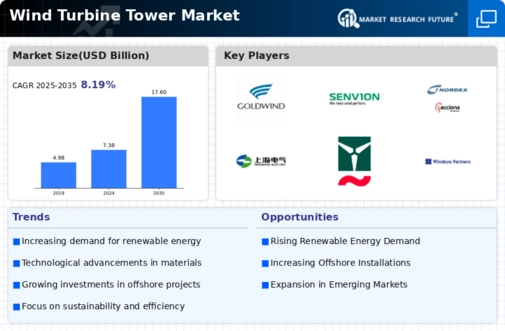Market Growth Projections
The Global Wind Turbine Tower Market Industry is poised for substantial growth, with projections indicating a market value of 7.38 USD Billion in 2024 and an anticipated increase to 17.6 USD Billion by 2035. This growth trajectory suggests a compound annual growth rate of 8.2% from 2025 to 2035. Such figures reflect the increasing global investment in wind energy infrastructure and the rising demand for renewable energy solutions. The market's expansion is likely to be driven by various factors, including technological advancements, government policies, and the urgent need for sustainable energy sources.
Global Climate Change Initiatives
Global climate change initiatives are significantly influencing the Global Wind Turbine Tower Market Industry. International agreements, such as the Paris Agreement, compel nations to commit to reducing greenhouse gas emissions. As a result, countries are ramping up their investments in renewable energy technologies, particularly wind power, to meet their climate targets. This trend is reflected in the anticipated growth of the market, with projections indicating a rise from 7.38 USD Billion in 2024 to 17.6 USD Billion by 2035. The urgency to combat climate change is likely to drive further advancements in wind turbine technology and infrastructure, thereby enhancing the demand for wind turbine towers.
Government Incentives and Subsidies
Government incentives and subsidies play a crucial role in stimulating the Global Wind Turbine Tower Market Industry. Many countries offer financial support for renewable energy projects, including tax credits, grants, and feed-in tariffs. Such measures lower the financial barriers for developers and encourage investments in wind energy infrastructure. For instance, the United States has implemented the Production Tax Credit, which significantly reduces the cost of wind energy production. These incentives not only enhance the feasibility of wind projects but also contribute to the overall growth of the market, as they create a more favorable investment climate for wind turbine tower installations.
Growing Demand for Renewable Energy
The increasing global emphasis on renewable energy sources is a primary driver of the Global Wind Turbine Tower Market Industry. Governments worldwide are implementing policies to reduce carbon emissions and promote sustainable energy solutions. For instance, the European Union aims to achieve climate neutrality by 2050, which necessitates a significant increase in wind energy capacity. This shift is reflected in the projected market value of 7.38 USD Billion in 2024, with expectations to reach 17.6 USD Billion by 2035. Such growth indicates a compound annual growth rate of 8.2% from 2025 to 2035, underscoring the critical role of wind turbine towers in meeting energy demands sustainably.
Technological Advancements in Wind Turbines
Technological innovations in wind turbine design and manufacturing are propelling the Global Wind Turbine Tower Market Industry forward. Enhanced turbine efficiency, larger rotor diameters, and improved materials contribute to higher energy output and lower costs. For example, the development of taller towers allows turbines to harness stronger winds at greater heights, significantly increasing energy generation potential. As these technologies evolve, they not only improve the performance of existing wind farms but also facilitate the establishment of new projects. This trend is likely to attract investments and drive market growth, aligning with the global shift towards more efficient renewable energy solutions.
Rising Energy Prices and Energy Security Concerns
The volatility of fossil fuel prices and the growing concerns over energy security are driving interest in the Global Wind Turbine Tower Market Industry. As countries seek to diversify their energy sources and reduce dependence on imported fuels, wind energy emerges as a viable alternative. The rising costs of traditional energy sources make wind energy increasingly attractive, as it offers a stable and predictable pricing model. This shift is evident in the increasing investments in wind energy infrastructure, which are expected to contribute to the market's growth trajectory. Consequently, the demand for wind turbine towers is likely to rise as nations prioritize energy independence and sustainability.



 Source: Primary Research, Secondary Research, MRFR Database and Analyst Review
Source: Primary Research, Secondary Research, MRFR Database and Analyst Review













